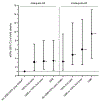Association of infant diet with subsequent obesity at 2-5 years among children exposed to gestational diabetes: the SWIFT study
- PMID: 33495846
- PMCID: PMC8016720
- DOI: 10.1007/s00125-020-05379-y
Association of infant diet with subsequent obesity at 2-5 years among children exposed to gestational diabetes: the SWIFT study
Abstract
Aims/hypotheses: This longitudinal analysis evaluated the independent and joint associations of any breastfeeding (BF) or exclusive BF (EBF) and intake of sugar-sweetened beverages (SSBs) and 100% fruit juice from birth to 1 year with subsequent overweight and obesity among young children exposed to gestational diabetes (GDM).
Methods: The analysis utilised prospectively collected data from participants enrolled in the Study of Women, Infant Feeding and Type 2 Diabetes after GDM (SWIFT); 1035 pregnant women (20-45 years) diagnosed with GDM, of whom 75% were of Black, Hispanic or Asian race and ethnicity. Mother-infant dyad characteristics and infant dietary intake were assessed via research protocols at in-person examinations, telephone interviews and monthly mailed surveys from birth to 1 year. Child weight, length and height were obtained from electronic health records at birth (2008-2011) and ages 2-5 years (2010-2016) to classify BMI percentile groups (n = 835).
Results: Adequate BF (≥6 months), adequate EBF duration (≥6 months), and SSB and 100% fruit juice intake in the first year were independently associated with child obesity at ages 2-5 years (all p < 0.05). Compared with children with adequate EBF and no intake of SSB or 100% fruit juice, those with adequate EBF and intake of 100% fruit juice and/or SSBs had a four- to fivefold higher odds of obesity (aOR 4.2, 95% CI:1.6, 11.2 for 100% fruit juice; aOR 4.5, 95% CI:1.4, 8.5 for fruit juice or SSBs; and aOR 4.7, 95% CI:1.4, 15 for SSBs; all p < 0.01), while those with inadequate EBF (<6 months) and intake of 100% fruit juice and/or SSBs had a six- to 12-fold higher odds of obesity (aOR 6.4, 95% CI:2.4, 17.2 for fruit juice; aOR 6.6, 95% CI:2.7, 14.8 for fruit juice or SSBs; and aOR 12.2, 95% CI:4.3, 25 for SSBs; all p < 0.001). Compared with children with adequate BF and no intake of SSB or 100% fruit juice, those with adequate BF and intake of 100% fruit juice and/or SSBs had a threefold higher odds of obesity (aOR 3.1, 95% CI:1.1, 7.3 for fruit juice; aOR 3.3, 95% CI:1.3, 8.3 for fruit juice or SSBs; and aOR 3.4, 95% CI:1.3, 8.5 for SSBs; all p < 0.05), while those with inadequate BF (<6 months) and intake of 100% fruit juice and/or SSB were associated with five- to tenfold higher odds of obesity (aOR 4.8, 95% CI:2.3, 12.2 for fruit juice; aOR 6.0, 95% CI:2.5, 12.8 for fruit juice or SSBs; aOR 9.5, 95% CI:3.7, 15.1 for SSBs; all p < 0.05).
Conclusions/interpretation: This is the first study to prospectively evaluate the relation of BF or EBF duration and intake of SSB and 100% fruit juice during the first year of life with subsequent obesity in children exposed to GDM. Adequate BF or EBF combined with avoidance of SSB and 100% fruit juice during early infancy may ameliorate future child obesity in this high-risk population.
Keywords: 100% fruit juice; BMI; Childhood obesity; Exclusive breastfeeding; Gestational diabetes mellitus; Infant diet; Sugar-sweetened beverages.
Figures


Similar articles
-
Fetal exposure to gestational diabetes severity and postnatal infant feeding in the first year of life associated with preadolescent obesity: a prospective cohort.Obesity (Silver Spring). 2025 May;33(5):996-1010. doi: 10.1002/oby.24261. Epub 2025 Mar 12. Obesity (Silver Spring). 2025. PMID: 40070166
-
Association of breastfeeding and early exposure to sugar-sweetened beverages with obesity prevalence in offspring born to mothers with and without gestational diabetes mellitus.Pediatr Obes. 2019 Dec;14(12):e12569. doi: 10.1111/ijpo.12569. Epub 2019 Aug 6. Pediatr Obes. 2019. PMID: 31389196 Free PMC article.
-
Association of Infant Temperament With Subsequent Obesity in Young Children of Mothers With Gestational Diabetes Mellitus.JAMA Pediatr. 2019 May 1;173(5):424-433. doi: 10.1001/jamapediatrics.2018.5199. JAMA Pediatr. 2019. PMID: 30855657 Free PMC article.
-
Postnatal Prevention of Childhood Obesity in Offspring Prenatally Exposed to Gestational Diabetes mellitus: Where Are We Now?Obes Facts. 2017;10(4):396-406. doi: 10.1159/000477407. Epub 2017 Aug 23. Obes Facts. 2017. PMID: 28848122 Free PMC article. Review.
-
Sugar-Sweetened Beverages and Metabolic Risk in Children and Adolescents with Obesity: A Narrative Review.Nutrients. 2023 Jan 30;15(3):702. doi: 10.3390/nu15030702. Nutrients. 2023. PMID: 36771409 Free PMC article. Review.
Cited by
-
Fetal exposure to gestational diabetes severity and postnatal infant feeding in the first year of life associated with preadolescent obesity: a prospective cohort.Obesity (Silver Spring). 2025 May;33(5):996-1010. doi: 10.1002/oby.24261. Epub 2025 Mar 12. Obesity (Silver Spring). 2025. PMID: 40070166
-
Gestational Diabetes, the Human Milk Metabolome, and Infant Growth and Adiposity.JAMA Netw Open. 2024 Dec 2;7(12):e2450467. doi: 10.1001/jamanetworkopen.2024.50467. JAMA Netw Open. 2024. PMID: 39666338 Free PMC article.
-
Intensive lactation among women with recent gestational diabetes significantly alters the early postpartum circulating lipid profile: the SWIFT study.BMC Med. 2021 Oct 8;19(1):241. doi: 10.1186/s12916-021-02095-1. BMC Med. 2021. PMID: 34620173 Free PMC article.
-
Breastfeeding may benefit cardiometabolic health of children exposed to increased gestational glycemia in utero.Eur J Nutr. 2022 Aug;61(5):2383-2395. doi: 10.1007/s00394-022-02800-7. Epub 2022 Feb 6. Eur J Nutr. 2022. PMID: 35124728 Free PMC article.
-
Early Infant Feeding Practices and Associations with Growth in Childhood.Nutrients. 2024 Feb 29;16(5):714. doi: 10.3390/nu16050714. Nutrients. 2024. PMID: 38474842 Free PMC article.
References
-
- Dabelea D, Sauder KA (2018) Intrauterine exposure to maternal diabetes and childhood obesity. In: Freemark MS (ed) Pediatric Obesity. Contemporary Endocrinology. Humana Press, Cham, pp 229–242
-
- Fryar CD, Carroll MD, Ogden CL (2016) Prevalence of overweight and obesity among children and adolescents aged 2–19 years: United States, 1963–1965 through 2013–2014. NCHS Heal E-Stats 1–5
-
- Hales CM, Carroll MD, Fryar CD, Ogden CL (2017) Prevalence of obesity among adults and youth: United States, 2015–2016. NCHS Data Brief (288):1–8 - PubMed
Publication types
MeSH terms
Grants and funding
LinkOut - more resources
Full Text Sources
Other Literature Sources
Medical
Miscellaneous

